Excerpts from Jim Conrad's
Naturalist Newsletter
Entry dated March 9, 2024, from notes taken about 2kms west of Higuerillas, Municipality of Cadereyta de Montes; N20.9086°, W99.7865°, elevation ~1760 meters (~5760 feet); on greywacke sandstone cap of hill; area constituting a narrow belt of the extreme southern extension of the Chihuahuan Desert, Meridional Subregion; central Querétaro state, MÉXICO
FEROCACTUS ECHIDNE ALMOST FLOWERING
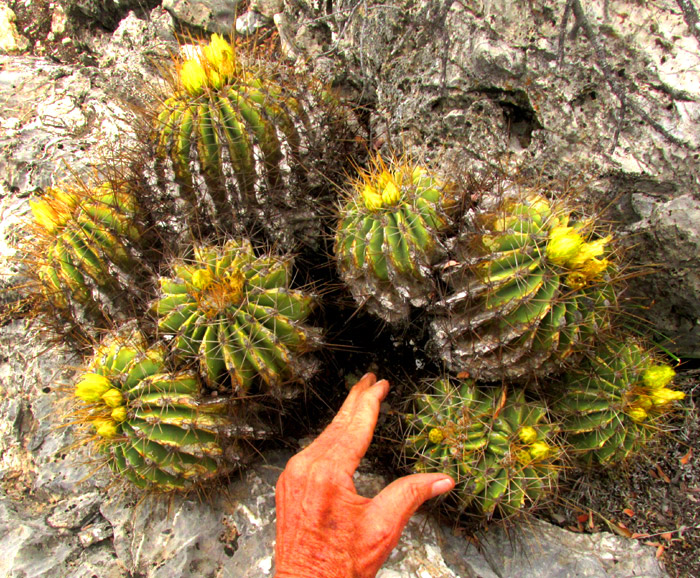
As documented in the bottom entry, last year I encountered Ferocactus echidne a few kilometers north of here and higher elevation; however, they bore no flowers. This year the above colony at least had partly open blossoms.

I'm unsure what the white crust atop the ribs' lower half signifies. It looks like callus which forms when the cactus body is damaged. On the CactiGuide.Com page for Cacti Pests & Diseases I find the same damage to a potted Ferocactus diagnosed as sunburn. However, the callus appears on our cacti's shaded parts as well. Atop the hill, the greywacke bedrock sometimes displayed wind erosion similar to that shown on our ventifacts page. Maybe the cactus ribs had been blasted with sandgrain-carrying wind. Insects and mites can cause callus formation with their piercing proboscises. And sometimes a similar callus formation results from the natural process of aging, and is referred to as "corking"; however, this colony's younger cacti also show the effect.
When identifying this species, sometimes it's unclear whether you might have be dealing with young, small individuals of Ferocactus histrix, which can grow much larger than this species, and which also occurs in this area. As seen above, the manner by which spines at the tops of Ferocactus echidne point upward all around the flowers is somewhat distinctive.
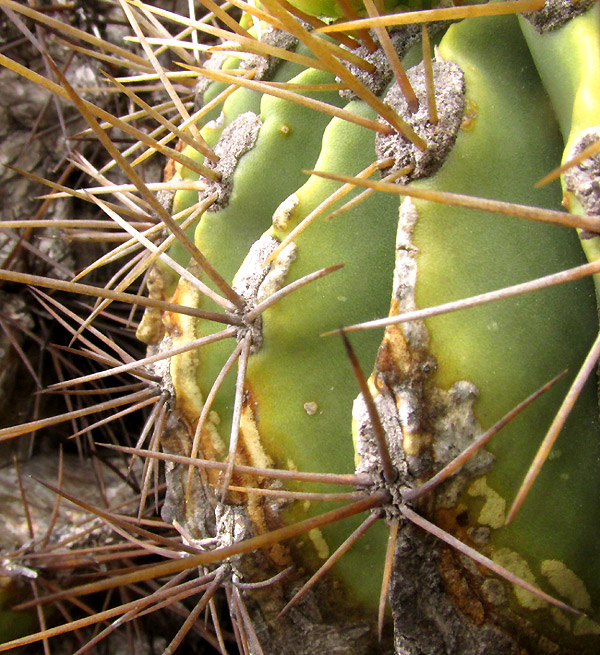
The above picture shows both the callusing closer up, as well as some unaffected spine cluster bases, the areoles.

Another feature distinguishing the two species is that, as seen above, sepals subtending the tepals are rounded, not sharply pointed as with Ferocactus histrix.
OPEN FLOWER
Later in the day, about 100m away, an individual was found with this blossom wide open:
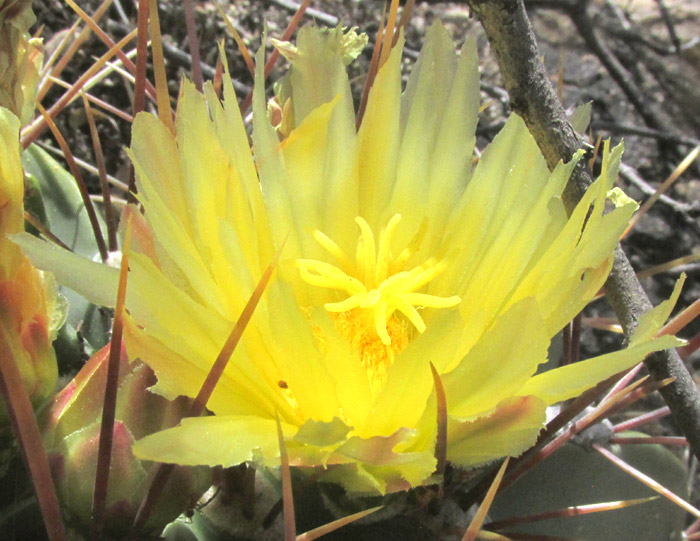
entry from field notes dated January 20, 2023, taken in scrub along ridgetop ~1.5km south of Camargo, elevation ±1,700m (7280 ft); bedrock of fine-grained, calcareous mudrock; Querétaro state, MÉXICO, (N21.09°, W99.73°)
FEROCACTUS ECHIDNE
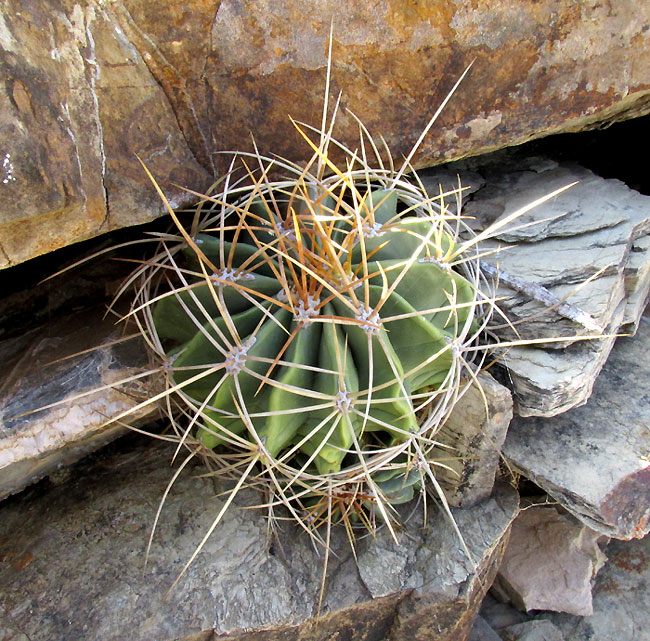
On a stone wall beside a dirt road running along a ridge, I wasn't sure the above cactus was rooted among the cracks, or had been perched there by a wandering soul. Searching in the scrub, the following one turned up definitely rooted in the thin, very dry soil:
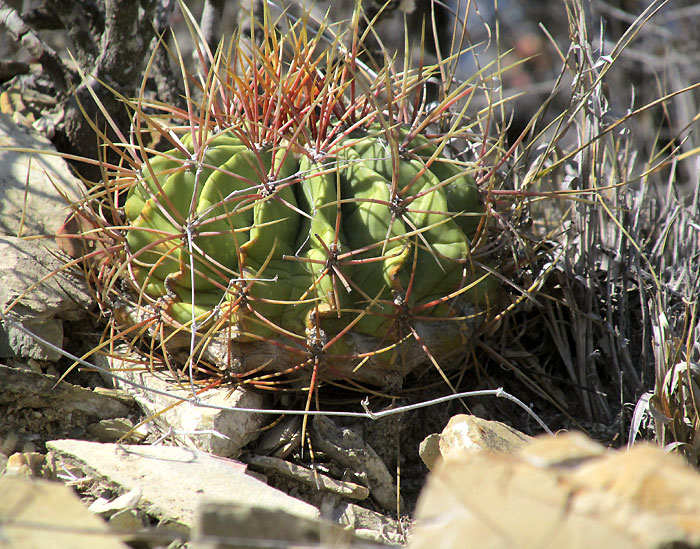
Without flowers or fruits, and with so many possible species in our semiarid, cactus-rich, upland central Mexico location, identification can be hard. This was a ribbed species with particularly long, slender, curving spines. Also, notice the whiteness covering the cactus body's lower part, like some kind of crust. When identifying this kind of cactus often it's necessary to know how many ribs it has: This one has 13.
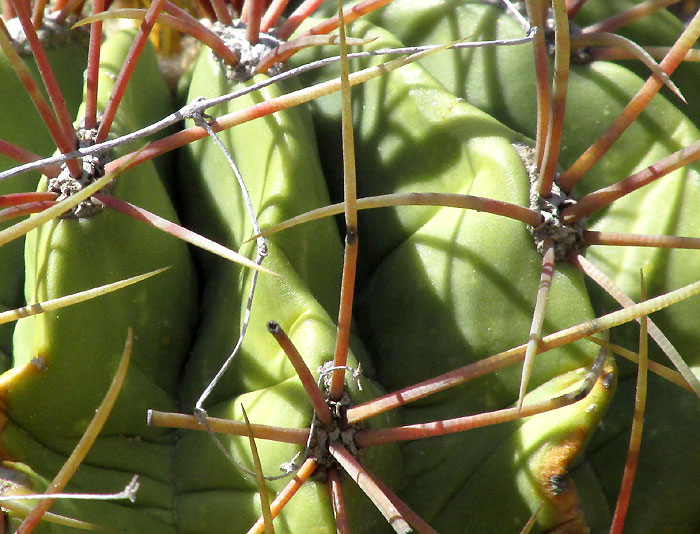
Surfaces of the distinct spots from which spine clusters arose, the areoles, were carpeted with very short, white hairs. The areoles tended to be teardrop shaped, with the trailing side directed upwardly, and they were fairly distant from one another along the ribs, not almost touching as in some species. The spines themselves were so thin that they easily broke. Areoles in our picture produced one central spine directed straight up, surrounded by about 8 radial spines. Here's a closer look at an areole:
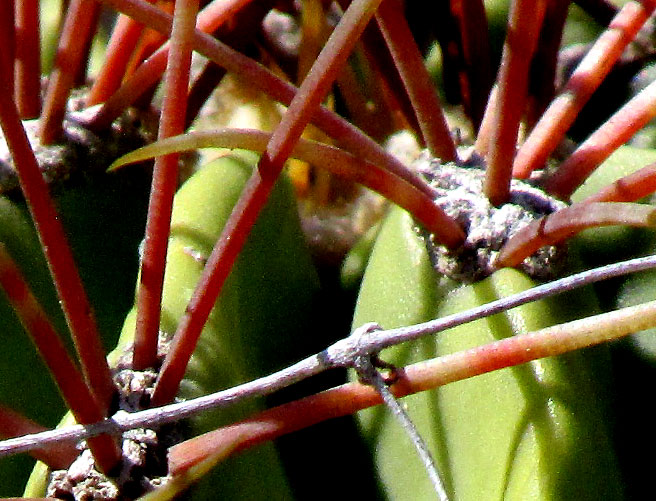
In our Bajío Region, referring to the Flora del Bajío, if you have a somewhat globe-shaped cactus with ribs, and the body's top is not capped with a mat of dense hairs, you can narrow the identification possibilities down to three genera: Echinocereus, Ferocactus and Stenocactus. My experience is that Echinocereus species may be globe-shaped when young, but more often even the juveniles show a tendency to elongate into a columnar form. Our plants give no indication of elongating. Stenocactus species tend to have more numerous and much narrower, wavier ribs than ours. These are undependable generalizations, but they do prejudice one for suspecting that probably the first best bet is to look into Ferocactus.
In our Bajío Region, if you have a small, globular Ferocactus with the areoles well distanced from one another, radial spines originating from both the top and bottom sides of the areoles, and with a single central spine, according to the Flora del Bajío, you have Ferocactus echidne. And if you look for pictures on the Internet identified under that name, all details mentioned above match the pictures, except that older plants elongate to form columnar cacti to about 40cm high (16inches).
Ferocactus echidne is the name most floras and lists on the Internet use for this species, and at this writing the Kew Plants of the World Online database accepts it. However, the GBIF database claims that now the species should be called Parrycactus echidne, which the Kew database rejects as a "homotypic synonym." Homotypic synonyms are different published names based on the exact same plant described in the publication when the species was first published. The Parrycactus echidne name was published in a Russian journal in 2000, while the Ferocactus name was published in 1922. Apparently most experts simply don't accept the Russian opinion, and refuse to recognize it, while others do. Here we'll file it under FEROCACTUS [PARRYCACTUS] ECHIDNE.
Ferocactus echidne is endemic just to the Eastern Sierra Madre mountains of northeastern and central Mexico, nicely shown on the GBIF distribution map, currently under the name Parrycactus echidne. It favors calcareous soils in open areas, often somewhat disturbed ones, and sometimes in tropical deciduous forests, including oak forests, from 550-1900m (1800-6250ft) in elevation.
The Internet abounds with pictures of Ferocactus echidne, nearly all growing in pots and rock gardens. Commercially often they're known as Sonora Barrel Cacti, though they don't grow in the Sonora Desert. There's a form, Ferocactus echidne f. monstruosus, which displays many growing variations, some crested, some an amorphous heap of lumps and warts, often lopsided, and considered highly collectible. At this writing, in Europe a small one in a plastic pot costs €48, or US$51. Sometimes they're grafted atop other cactus species.